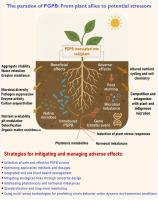The dual nature of plant growth-promoting bacteria: Benefits, risks, and pathways to sustainable deployment
IF 5.8
Q1 MICROBIOLOGY
引用次数: 0
Abstract
Plant growth-promoting bacteria (PGPB) are pivotal in sustainable agriculture, enhancing crop productivity and reducing reliance on chemical inputs. However, their dual role as beneficial agents and potential stressors remains underexplored. This review examines the paradoxical adverse effects of PGPB, challenging the predominantly optimistic narrative surrounding their use. At the plant level, unintended consequences include hormonal imbalances (e.g., auxin-induced root inhibition), phytotoxic metabolite production (e.g., hydrogen cyanide), and trade-offs between growth and defense mechanisms. At the soil level, risks encompass disrupted microbial diversity, altered nutrient cycling, and horizontal gene transfer that may foster pathogenicity. These outcomes are driven by environmental factors (soil pH and moisture), host-specific interactions, and application practices. Mitigation strategies emphasize rigorous strain selection, optimized dosing, and integrated soil management to balance efficacy with ecological safety. Advances in multi-omics technologies and synthetic consortia design offer predictive insights into strain behavior, while long-term ecological assessments are critical to address legacy impacts. The review underscores the necessity of a nuanced, evidence-based approach to PGPB deployment, harmonizing agricultural benefits with environmental stewardship. By addressing knowledge gaps in microbial ecology and risk assessment, this work supports strategies prioritizing both agricultural resilience and soil biodiversity to ensure PGPB contribute sustainably to global food security.

促进植物生长的细菌的双重性质:利益、风险和可持续部署的途径
植物生长促进菌(PGPB)在可持续农业、提高作物生产力和减少对化学品投入的依赖方面发挥着关键作用。然而,它们作为有益剂和潜在压力源的双重作用仍未得到充分探索。本综述考察了PGPB自相矛盾的不良影响,挑战了围绕其使用的主要乐观叙述。在植物层面,意想不到的后果包括激素失衡(如生长素诱导的根抑制)、植物毒性代谢物产生(如氰化氢)以及生长和防御机制之间的权衡。在土壤层面,风险包括微生物多样性被破坏、养分循环改变以及可能促进致病性的水平基因转移。这些结果是由环境因素(土壤pH值和湿度)、宿主特异性相互作用和应用实践驱动的。缓解策略强调严格的菌株选择、优化的剂量和综合的土壤管理,以平衡功效与生态安全。多组学技术和合成联合体设计的进步为菌株行为提供了预测性见解,而长期生态评估对于解决遗留影响至关重要。该评估强调,有必要采取一种细致入微、以证据为基础的方法来部署PGPB,使农业效益与环境管理相协调。通过解决微生物生态学和风险评估方面的知识缺口,这项工作支持优先考虑农业恢复力和土壤生物多样性的战略,以确保PGPB可持续地为全球粮食安全做出贡献。
本文章由计算机程序翻译,如有差异,请以英文原文为准。
求助全文
约1分钟内获得全文
求助全文
来源期刊

Current Research in Microbial Sciences
Immunology and Microbiology-Immunology and Microbiology (miscellaneous)
CiteScore
7.90
自引率
0.00%
发文量
81
审稿时长
66 days
 求助内容:
求助内容: 应助结果提醒方式:
应助结果提醒方式:


